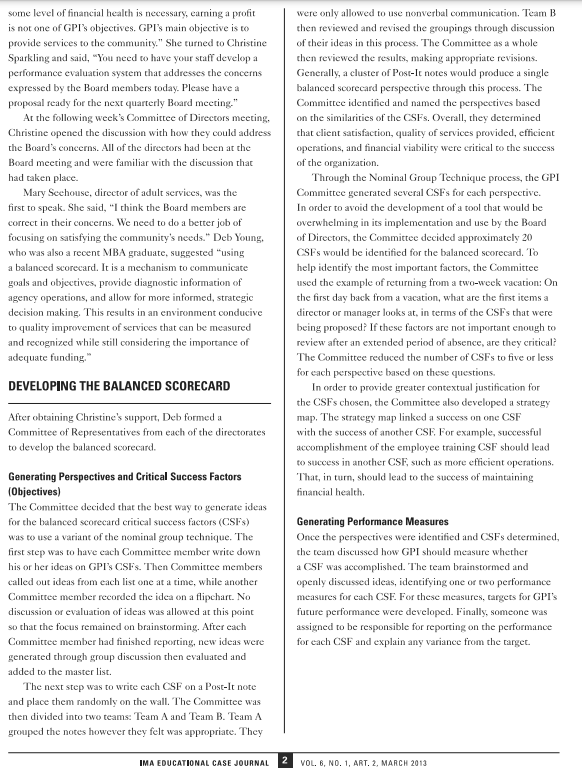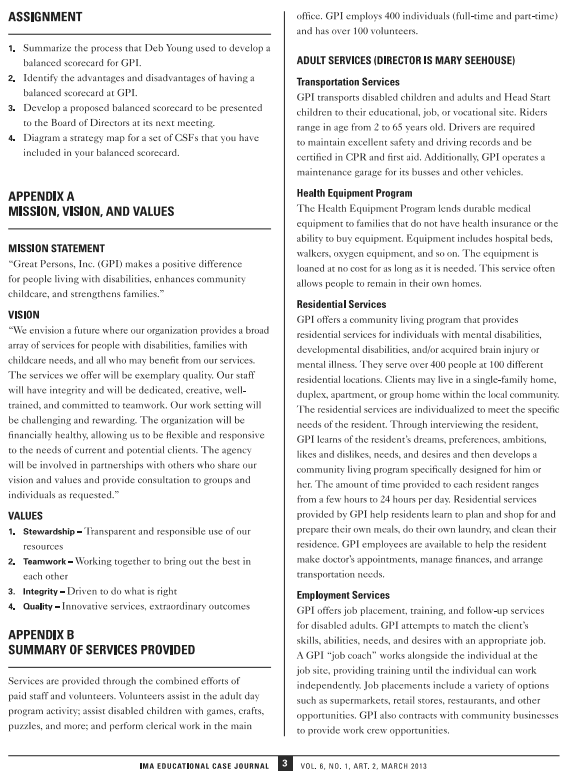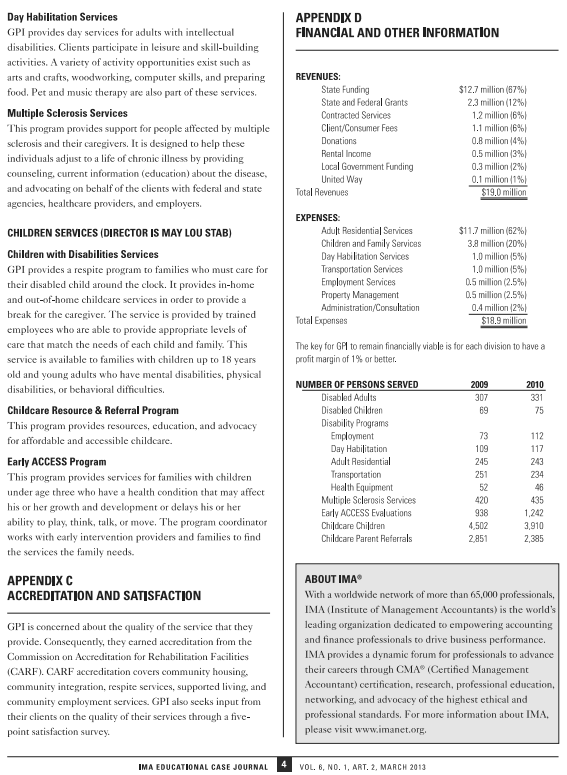Answered step by step
Verified Expert Solution
Question
1 Approved Answer
Summarize the process that Deb Young used to develop a balanced scorecard for GPI. 2. Identify the advantages and disadvantages of having a balanced scorecard
Summarize the process that Deb Young used to develop a balanced scorecard for GPI. 2. Identify the advantages and disadvantages of having a balanced scorecard at GPI. 3. Develop a proposed balanced scorecard to be presented to the Board of Directors at its next meeting. 4. Diagram a strategy map for a set of CSFs that you have included in your balanced scorecard.




some level of financial health is necessary, earning a profit is not one of GPI's objectives. GPI's main objective is to provide services to the community." She turned to Christine Sparkling and said, "You need to have your staff develop a performance evaluation system that addresses the concerns expressed by the Board members today. Please have a proposal ready for the next quarterly Board meeting." At the following week's Committee of Directors meeting, Christine opened the discussion with how they could address the Board's concerns. All of the directors had been at the Board meeting and were familiar with the discussion that had taken place. Mary Seehouse, director of adult services, was the first to speak. She said, "I think the Board members are correct in their concerns. We need to do a better job of focusing on satisfying the community's needs." Deb Young, who was also a recent MBA graduate, suggested "using a balanced scorecard. It is a mechanism to communicate goals and objectives, provide diagnostic information of agency operations, and allow for more informed, strategic decision making. This results in an environment conducive to quality improvement of services that can be measured and recognized while still considering the importance of adequate funding." DEVELOPING THE BALANCED SCORECARD After obtaining Christine's support, Deb formed a Committee of Representatives from each of the directorates to develop the balanced scorecard. Generating Perspectives and Critical Success Factors (Objectives) The Committee decided that the best way to generate ideas for the balanced scorecard critical success factors (CSFs) was to use a variant of the nominal group technique. The first step was to have each Committee member write down his or her ideas on GPI's CSFs. Then Committee members called out ideas from each list one at a time, while another Committee member recorded the idea on a flipchart. No discussion or evaluation of ideas was allowed at this point so that the focus remained on brainstorming. After each Committee member had finished reporting, new ideas were generated through group discussion then evaluated and added to the master list. The next step was to write each CSF on a Post-It note and place them randomly on the wall. The Committee was then divided into two teams: Team A and Team B. Team A grouped the notes however they felt was appropriate. They were only allowed to use nonverbal communication. Team B then reviewed and revised the groupings through discussion of their ideas in this process. The Committee as a whole then reviewed the results, making appropriate revisions. Generally, a cluster of Post-It notes would produce a single balanced scorecard perspective through this process. The Committee identified and named the perspectives based on the similarities of the CSFs. Overall, they determined that client satisfaction, quality of services provided, efficient operations, and financial viability were critical to the success of the organization. Through the Nominal Group Technique process, the GPI Committee generated several CSFs for each perspective. In order to avoid the development of a tool that would be overwhelming in its implementation and use by the Board of Directors, the Committee decided approximately 20 CSFs would be identified for the balanced scorecard. To help identify the most important factors, the Committee used the example of returning from a two-week vacation: On the first day back from a vacation, what are the first items a director or manager looks at, in terms of the CSF's that were being proposed? If these factors are not important enough to review after an extended period of absence, are they critical? The Committee reduced the number of CSFs to five or less for each perspective based on these questions. In order to provide greater contextual justification for the CSF's chosen, the Committee also developed a strategy map. The strategy map linked a success on one CSF with the success of another CSF. For example, successful accomplishment of the employee training CSF should lead to success in another CSF, such as more efficient operations. That, in turn, should lead to the success of maintaining financial health. Generating Performance Measures Once the perspectives were identified and CSFs determined, the team discussed how GPI should measure whether a CSF was accomplished. The team brainstormed and openly discussed ideas, identifying one or two performance measures for each CSF. For these measures, targets for GPI's future performance were developed. Finally, someone was assigned to be responsible for reporting on the performance for each CSF and explain any variance from the target. IMA EDUCATIONAL CASE JOURNAL 2 VOL. 6, NO. 1, ART. 2, MARCH 2013
Step by Step Solution
There are 3 Steps involved in it
Step: 1

Get Instant Access to Expert-Tailored Solutions
See step-by-step solutions with expert insights and AI powered tools for academic success
Step: 2

Step: 3

Ace Your Homework with AI
Get the answers you need in no time with our AI-driven, step-by-step assistance
Get Started


